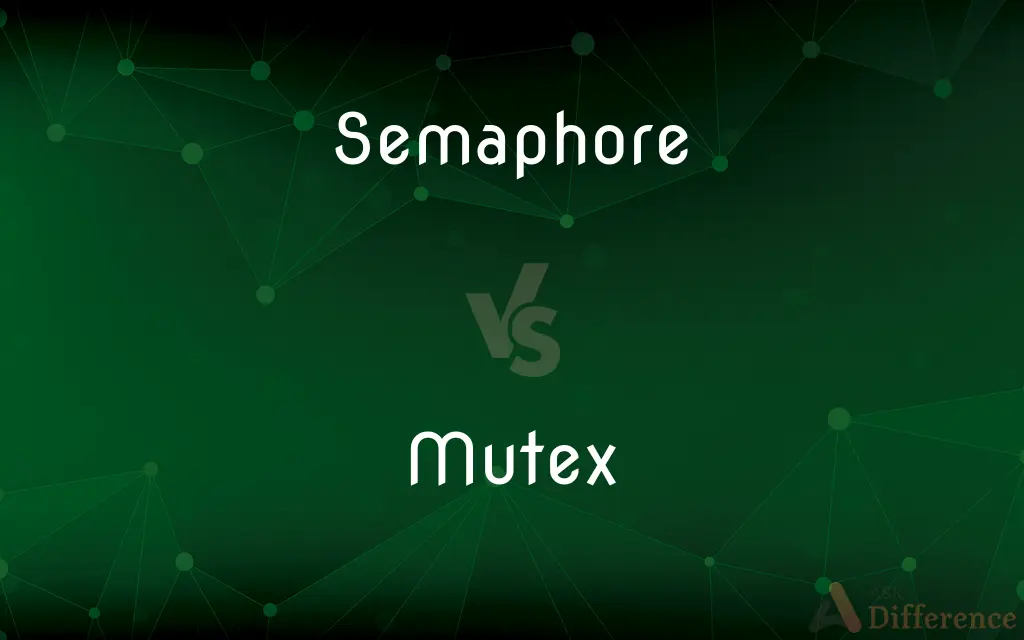Semaphore vs. Mutex — What's the Difference?
Edited by Tayyaba Rehman — By Urooj Arif — Updated on April 20, 2024
Semaphore controls access for multiple instances to a resource, suitable for counting, while a mutex is a locking mechanism ensuring exclusive access for a single thread.

Difference Between Semaphore and Mutex
Table of Contents
ADVERTISEMENT
Key Differences
A semaphore is a signaling mechanism that can manage access by multiple processes or threads to a common resource, indicating how many units of that resource are available. On the other hand, a mutex (mutual exclusion object) is designed to prevent multiple threads from accessing a piece of code or data simultaneously, thus preventing race conditions.
Semaphores can be configured as counting semaphores, where the count represents the number of available resources. Whereas, a mutex is essentially a binary semaphore, which can only be either locked or unlocked, indicating whether a resource is available.
When a semaphore’s count decreases to zero, no further processes can proceed until the semaphore is incremented again. On the other hand, when a mutex is locked by a thread, other threads attempting to acquire the mutex are blocked until the mutex is unlocked.
Semaphores are generally used for managing a limited number of identical resources. In contrast, mutexes are used to secure exclusive access to resources, ensuring that only one thread can execute a particular section of code at a time.
Semaphores can be useful in scenarios where an application needs to limit access to multiple instances of a resource. Conversely, mutexes are critical in protecting data integrity by ensuring that only one thread can access a resource or perform a critical section of code at any given time.
ADVERTISEMENT
Comparison Chart
Basic Concept
Signaling mechanism for managing access to resources
Locking mechanism for exclusive access
Usage
Multiple processes can decrease/increase count
Only one thread at a time can lock/unlock
Type
Counting or binary
Binary only
Access Control
Can control multiple instances
Single instance control
Typical Use
Managing a set number of identical resources
Protecting critical sections of code
Compare with Definitions
Semaphore
A signaling mechanism that can be incremented or decremented by acquiring or releasing a resource.
When a thread finishes its task, it increments the semaphore count to signal resource availability.
Mutex
Often used to protect the integrity of data structures and prevent data races.
A database system might use a mutex to lock a record during an update.
Semaphore
A tool used to control access to a common resource through the use of a counter.
A semaphore with a count of 10 allows up to 10 threads to access the resource concurrently.
Mutex
Critical in managing threads in complex systems where multiple resources are accessed.
In a banking application, mutexes ensure that account balance updates are not concurrent.
Semaphore
Used in managing resource pools where multiple identical resources are shared among competing processes.
A print server may use a semaphore to manage a pool of printers.
Mutex
A synchronization primitive that allows only one thread to access a resource or critical section at any time.
A mutex guards the access to a shared data structure in a multithreaded application.
Semaphore
Can be binary (semaphore with a maximum count of one) or general (counting semaphore).
Binary semaphores are often used similarly to mutexes but are not the same.
Mutex
Prevents race conditions by ensuring mutual exclusion in accessing shared resources.
By locking a mutex while updating a shared counter, threads avoid corrupting the value.
Semaphore
Facilitates coordination between processes, particularly in producer/consumer scenarios.
Semaphores help maintain balance between producing and consuming rates in buffer management.
Mutex
Cannot be used by the same thread that locked it unless it first releases the lock.
If a thread attempts to lock a mutex it already holds, it can lead to a deadlock.
Semaphore
A visual signaling apparatus with flags, lights, or mechanically moving arms, as one used on a railroad.
Mutex
(programming) An object in a program that serves as a lock, used to negotiate mutual exclusion among threads.
Semaphore
A visual system for sending information by means of two flags that are held one in each hand, using an alphabetic code based on the position of the signaler's arms.
Mutex
To apply a mutex to.
Semaphore
To send (a message) or to signal by semaphore.
Semaphore
Any equipment used for visual signalling by means of flags, lights, or mechanically moving arms, which are used to represent letters of the alphabet, or words.
Semaphore
(figurative) A visual system for transmitting information using the above equipment; especially, by means of two flags held one in each hand, using an alphabetic and numeric code based on the position of the signaller's arms; flag semaphore.
Semaphore
(computing) A bit, token, fragment of code, or some other mechanism which is used to restrict access to a shared function or device to a single process at a time, or to synchronize and coordinate events in different processes.
The thread increments the semaphore to prevent other threads from entering the critical section at the same time.
Semaphore
To signal using, or as if using, a semaphore, with the implication that it is done nonverbally.
Semaphore
A signal telegraph; an apparatus for giving signals by the disposition of lanterns, flags, oscillating arms, etc.
Semaphore
An apparatus for visual signaling with lights or mechanically moving arms
Semaphore
Send signals by or as if by semaphore
Semaphore
Convey by semaphore, of information
Common Curiosities
What is the main purpose of a semaphore?
To manage and synchronize access to shared resources by multiple threads or processes through a counter mechanism.
What happens when a thread tries to lock a mutex that is already locked?
When a thread attempts to lock a mutex that is already locked by another thread, it will block or enter a waiting state until the mutex is unlocked by the owning thread.
What are common use cases for a mutex?
Protecting access to shared data structures, ensuring thread-safe operations in critical sections of code, and preventing data races.
Are semaphores reentrant like mutexes can be?
Generally, semaphores are not reentrant because they do not track the identity of the thread that modified their count. In contrast, some mutex implementations are reentrant, allowing the same thread to lock the mutex multiple times without causing a deadlock.
Can mutexes cause deadlocks? How?
Yes, mutexes can lead to deadlocks if several threads attempt to acquire multiple mutexes in inconsistent order and end up waiting indefinitely for each other to release the mutexes they hold.
When should you use a semaphore instead of a mutex?
When the application requires several threads to access the same type of resource simultaneously, a semaphore is suitable as it can handle multiple accesses based on its count.
How does a counting semaphore work?
A counting semaphore maintains a set limit that represents the number of available resources or slots. When a thread acquires the semaphore, it decrements this count, and when releasing it, increments the count. Threads will block if they attempt to acquire the semaphore when the count is zero.
How does a mutex differ from a semaphore in its functionality?
A mutex is designed for mutual exclusion and can only be held by one thread at a time to protect critical sections, whereas a semaphore can control access by multiple threads based on a count.
Can a semaphore be used as a mutex?
Yes, a binary semaphore with a count of one can function similarly to a mutex but lacks some mutex-specific optimizations and features.
What is the advantage of using a binary semaphore over a mutex?
While binary semaphores and mutexes are similar in that they both ensure exclusive access, binary semaphores might be used in systems where semaphores are supported but mutexes are not, or where semaphore usage is more aligned with existing architecture or coding practices. However, mutexes are generally preferred for mutual exclusion due to better support for ownership, priority inheritance, and deadlock avoidance.
Share Your Discovery

Previous Comparison
Passion vs. Profession
Next Comparison
Pajamas vs. SweatpantsAuthor Spotlight
Written by
Urooj ArifUrooj is a skilled content writer at Ask Difference, known for her exceptional ability to simplify complex topics into engaging and informative content. With a passion for research and a flair for clear, concise writing, she consistently delivers articles that resonate with our diverse audience.
Edited by
Tayyaba RehmanTayyaba Rehman is a distinguished writer, currently serving as a primary contributor to askdifference.com. As a researcher in semantics and etymology, Tayyaba's passion for the complexity of languages and their distinctions has found a perfect home on the platform. Tayyaba delves into the intricacies of language, distinguishing between commonly confused words and phrases, thereby providing clarity for readers worldwide.














































